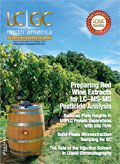Introduction to Preparative HPLC
LCGC North America
An overview of the principles and equipment required for scaling analytical separations to the preparative scale and considerations for the scale of analyte required.
The primary objective of an analytical-scale separation is to produce a chromatogram with sharp, well resolved, symmetrical peaks to yield the required analytical information. The goal of preparative-scale high performance liquid chromatography (HPLC) is to produce a quantity of pure compound as easily as possible in the most economical way, ultimately depositing the sample into a sample collector vessel before recovery from the eluent.
Preparative chromatography can be performed with an analytical column (and system) to produce a few micrograms of material, up to process scale, providing a ton quantities of sample, which use 1-m-long, 200-mm i.d columns. The larger the quantity of analyte required, the further the technique is removed from analytical chromatography, both in terms of scale and ideology; the bigger the scale, the more "nonchromatographic" parameters have to be considered. Some key downstream considerations in preparative chromatography include
- The amount of material recovered will directly govern the size of the preparative HPLC column chosen and the concentration and number of injections of crude sample required to achieve the desired target analyte mass.
- An analytical method that requires a complex gradient may prove difficult to replicate on a large scale.
- Large amounts of water, buffer salts, or modifiers in the eluent may cause problems at a later stage if their removal requires complex and costly processing.
- The stationary-phase chemistry and particle size should be scalable.
- Elevated temperatures may prove costly to reproduce on a large scale.
Many preparative separations undertaken within the laboratory begin life with a separation carried out at analytical scale. One must develop an analytical method in which the selectivity of the target analytes is maximized. In this way, the amount of analyte that can be loaded onto the column (and hence recovered from the column) per injection is optimized. Elution of analytes in more highly organic fractions is preferred from a sample recovery perspective as these fractions are more quickly and cost effectively processed.
Studies of the "loadability" of an analytical column are typically carried out using a "standard" 150 mm × 4.6 mm analytical column with 5-μm packing material. As the analyte amount on column increases, the peak shape will deteriorate until resolution is lost between the target analytes; this capacity determines the column loadability for a "touching band" type preparative separation. It is possible to "heart cut" overlapping bands within a separation (where selectivity cannot be further optimized for example), and the fractions can be reinjected to obtain increasingly pure material — however, this approach is much more cumbersome. In separations where selectivity is not the limiting factor, the loading capacity of the column is typically defined by breakthrough, the point at which increasing the amount of analyte on column does not increase peak height or area because the excess analyte cannot bind to the stationary-phase surface.
When the sample of interest has good solubility in the mobile phase, concentration overload is the technique of choice and sample concentration is increased while the injected sample volume remains constant. Column efficiency (as dictated by particle size) has little effect on concentration overloading, and the selectivity of the separation tends to be the dominant factor. When increasing the sample concentration, it may be necessary to use cosolvents within the diluent (dimethyl sulfoxide and dimethylformamide are popular) to improve sample solubility. If the diluent is more highly eluotropic than the eluent, however, problems can arise with peak shape and with precipitation during post-injection mixing with the eluent (which limits loadability).
When the sample of interest has limited solubility in the mobile phase, then volume overload is the technique of choice and sample volume is increased while the sample concentration remains constant. Volume overloading is heavily influenced by stationary-phase particle size and column diameter. Most preparative chromatography methods use a mixture of concentration and volume overloading to obtain the maximum amount of analyte on column per injection.
After the analytical-scale method has been developed and the loading factor has been estimated, the method can be scaled up using various simple calculations and estimation methods. Scalable factors include eluent flow rate, column internal diameter, gradient profile, sample volume loaded, solvent consumption, total fraction volume, and yield. A detailed treatment of various approaches to method scale-up can be found in the accompanying CHROMacademy Essential Guide on-line article.
Preparative HPLC equipment differs from analytical scale only in the capability to deliver very high flow rates (100 mL/min is not unusual in a laboratory-scale semipreparative separation), and typically the inclusion of a fraction-collection device for automated sample recovery. Preparative fractions are typically collected by means of a diverter valve that can be triggered either by time settings or detector signal. If the fraction collection is time based, then one must take care to avoid analyte retention time drift. Where the collection is triggered by mass (using mass spectrometry detection), a response threshold, or a rate of change in detector response, the delay volume (time) between the detector and the fraction collector nozzle must be carefully calibrated to ensure precious sample is not lost.

New Study Reviews Chromatography Methods for Flavonoid Analysis
April 21st 2025Flavonoids are widely used metabolites that carry out various functions in different industries, such as food and cosmetics. Detecting, separating, and quantifying them in fruit species can be a complicated process.
Extracting Estrogenic Hormones Using Rotating Disk and Modified Clays
April 14th 2025University of Caldas and University of Chile researchers extracted estrogenic hormones from wastewater samples using rotating disk sorption extraction. After extraction, the concentrated analytes were measured using liquid chromatography coupled with photodiode array detection (HPLC-PDA).

.png&w=3840&q=75)

.png&w=3840&q=75)



.png&w=3840&q=75)



.png&w=3840&q=75)





